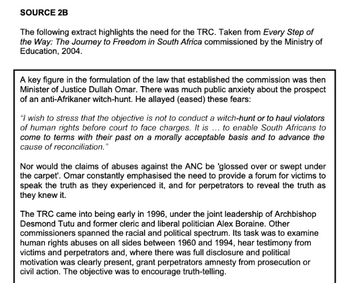Question
|
2.2.1 |
Define the following historical concepts: a) Amnesty b) Reconciliation |
|
2.2.2 |
Who was Dullah Omar? |
|
2.2.3 |
Give TWO examples from the source of how Dullah Omar tried to ease the fears of Afrikaners. |

Transcribed Image Text:SOURCE 2B
The following extract highlights the need for the TRC. Taken from Every Step of
the Way: The Journey to Freedom in South Africa commissioned by the Ministry of
Education, 2004.
A key figure in the formulation of the law that established the commission was then
Minister of Justice Dullah Omar. There was much public anxiety about the prospect
of an anti-Afrikaner witch-hunt. He allayed (eased) these fears:
"I wish to stress that the objective is not to conduct a witch-hunt or to haul violators
of human rights before court to face charges. It is ... to enable South Africans to
come to terms with their past on a morally acceptable basis and to advance the
cause of reconciliation."
Nor would the claims of abuses against the ANC be 'glossed over or swept under
the carpet'. Omar constantly emphasised the need to provide a forum for victims to
speak the truth as they experienced it, and for perpetrators to reveal the truth as
they knew it.
The TRC came into being early in 1996, under the joint leadership of Archbishop
Desmond Tutu and former cleric and liberal politician Alex Boraine. Other
commissioners spanned the racial and political spectrum. Its task was to examine
human rights abuses on all sides between 1960 and 1994, hear testimony from
victims and perpetrators and, where there was full disclosure and political
motivation was clearly present, grant perpetrators amnesty from prosecution or
civil action. The objective was to encourage truth-telling.
Expert Solution
This question has been solved!
Explore an expertly crafted, step-by-step solution for a thorough understanding of key concepts.
Step by stepSolved in 2 steps
